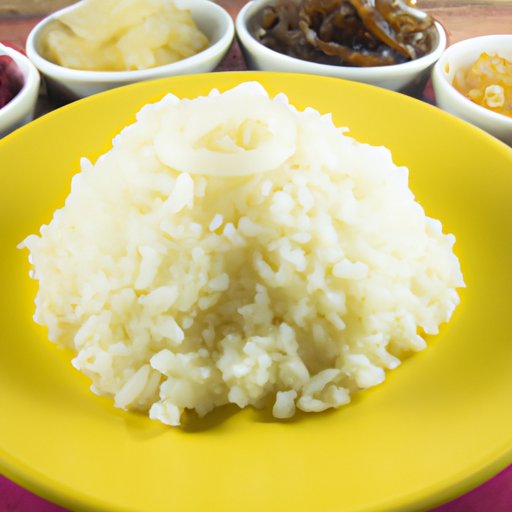
Introduction
If you’re avoiding gluten in your diet, you may be wondering if sticky rice is a safe and tasty option. After all, rice is a staple food for many cultures and cuisines, and it’s often a go-to ingredient for gluten-free cooking. In this comprehensive guide, we’ll explore whether sticky rice is gluten-free and why it’s a great choice for people with celiac disease or gluten sensitivity. We’ll also share tips and recipes for cooking with sticky rice that are sure to satisfy your cravings for delicious and safe gluten-free meals.
Exploring the Gluten-Free Benefits of Sticky Rice: A Comprehensive Guide
Before we dive into the topic of sticky rice and gluten, let’s first define what gluten is and why it’s important to avoid for people with celiac disease or gluten sensitivity. Gluten is a protein found in wheat, barley, and rye, which can cause a range of symptoms in people who are intolerant or allergic to it, including digestive issues, skin rashes, and fatigue.
So, is sticky rice gluten-free? The short answer is yes, sticky rice is gluten-free. Unlike wheat or barley, rice does not contain gluten, making it a safe and versatile option for people with gluten sensitivities. Sticky rice, in particular, has a unique texture that makes it perfect for gluten-free cooking and baking.
Sticky rice, also known as glutinous rice or sweet rice, is a type of rice that is stickier and chewier than other varieties of rice. It gets its characteristic texture from a type of starch called amylopectin, which is higher in sticky rice than in other types of rice. This makes sticky rice a great ingredient for gluten-free dishes that require a sticky or gummy texture, like sushi rolls or rice pudding.
The Scoop on Sticky Rice: Understanding Gluten Content and Recipes
Sticky rice is typically prepared by soaking the rice in water for several hours, then steaming it until it becomes soft and chewy. To enhance its flavor, it’s often cooked with coconut milk, sugar, or other spices and seasonings.
When it comes to determining whether a particular brand or type of sticky rice is gluten-free, it’s important to read the label carefully and look for any potential sources of gluten. Some brands may be cross-contaminated with gluten-containing grains during processing, so it’s essential to do your research and choose brands that are certified gluten-free.
To get you started, here are a few basic recipes for cooking with sticky rice that are gluten-free:
- Coconut sticky rice: Cook sticky rice with coconut milk and a bit of sugar for a sweet and creamy treat.
- Sticky rice with mango: Top sticky rice with fresh mango slices for a tropical dessert.
- Sticky rice balls: Mix sticky rice with sweetened red bean paste and shape into balls for a Chinese-inspired snack.
Sticky Rice: A Gluten-Free Alternative for Rice Lovers
If you’re a fan of rice dishes but need to avoid gluten, sticky rice is a great alternative to other types of rice, like brown rice, wild rice, or jasmine rice. Not only is it gluten-free, but it also has a unique texture and flavor that make it ideal for a variety of recipes.
Sticky rice is a great choice for gluten-free eaters who want to enjoy rice dishes like sushi, rice bowls, and desserts. It’s especially useful for making sushi rolls, as its stickiness helps hold the ingredients together. Sticky rice can also be used to make rice balls, rice puddings, and other sweet or savory treats.
Going Gluten-Free? Try Sticky Rice for a Tasty and Safe Option
If you’re new to gluten-free eating, it can be challenging to navigate all the different foods and ingredients that contain gluten. However, by incorporating sticky rice into your diet, you can enjoy a range of delicious and safe meals that are sure to satisfy your cravings.
Some tips for incorporating sticky rice into your gluten-free diet include:
- Try substituting sticky rice for other types of rice in your favorite dishes.
- Experiment with different sauces and seasonings to enhance the flavor of your sticky rice dishes.
- Use sticky rice in place of bread or other gluten-containing grains in lunch or dinner bowls.
Remember that gluten-free eating is all about finding delicious and healthy alternatives to the foods you love. By using sticky rice in your cooking and baking, you can enjoy a variety of satisfying and tasty meals that are gluten-free and safe for your diet.
From Sushi Rolls to Mango Sticky Rice: Gluten-Free Options for Your Favorite Sticky Rice Dishes
Now that you’ve learned all about the gluten-free benefits of sticky rice, it’s time to start cooking! Here are some ideas for gluten-free sticky rice dishes you can make at home:
- California sushi rolls: Fill sushi rolls with avocado, crab meat, and sticky rice for a gluten-free take on this classic dish.
- Sticky rice pudding: Combine cooked sticky rice with coconut milk, cinnamon, and raisins for a warm and comforting dessert.
- Mango sticky rice: Top sticky rice with sliced mango and a drizzle of coconut milk for a refreshing and tropical treat.
For more recipe ideas and inspiration, check out gluten-free cooking blogs and websites that specialize in rice dishes. You can also share your own favorite gluten-free sticky rice recipes and tips with others in online forums and social media groups.
Conclusion
Sticky rice is a gluten-free and versatile ingredient that is perfect for a wide variety of recipes, from sushi rolls to rice pudding. By understanding the gluten content of different types of sticky rice and how to prepare it, you can enjoy a range of satisfying and delicious meals that are safe for your diet.
Remember to always read labels carefully and choose brands that are certified gluten-free to avoid any potential cross-contamination.




